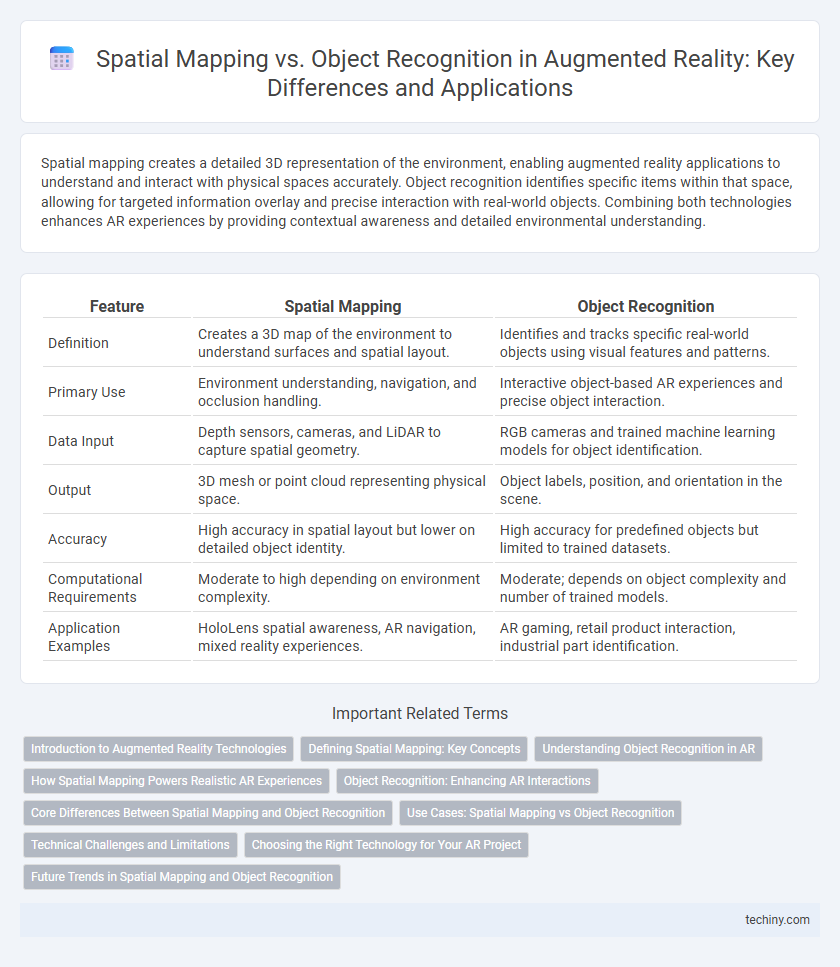Spatial mapping creates a detailed 3D representation of the environment, enabling augmented reality applications to understand and interact with physical spaces accurately. Object recognition identifies specific items within that space, allowing for targeted information overlay and precise interaction with real-world objects. Combining both technologies enhances AR experiences by providing contextual awareness and detailed environmental understanding.
Table of Comparison
| Feature | Spatial Mapping | Object Recognition |
|---|---|---|
| Definition | Creates a 3D map of the environment to understand surfaces and spatial layout. | Identifies and tracks specific real-world objects using visual features and patterns. |
| Primary Use | Environment understanding, navigation, and occlusion handling. | Interactive object-based AR experiences and precise object interaction. |
| Data Input | Depth sensors, cameras, and LiDAR to capture spatial geometry. | RGB cameras and trained machine learning models for object identification. |
| Output | 3D mesh or point cloud representing physical space. | Object labels, position, and orientation in the scene. |
| Accuracy | High accuracy in spatial layout but lower on detailed object identity. | High accuracy for predefined objects but limited to trained datasets. |
| Computational Requirements | Moderate to high depending on environment complexity. | Moderate; depends on object complexity and number of trained models. |
| Application Examples | HoloLens spatial awareness, AR navigation, mixed reality experiences. | AR gaming, retail product interaction, industrial part identification. |
Introduction to Augmented Reality Technologies
Spatial mapping in augmented reality creates detailed 3D models of environments for accurate device positioning and interaction, while object recognition identifies and tracks specific real-world items to trigger digital content. These technologies enhance AR experiences by enabling context-aware applications, improving user immersion and interaction precision. Effective integration of spatial mapping and object recognition drives advancements in fields like gaming, architecture, and industrial maintenance.
Defining Spatial Mapping: Key Concepts
Spatial mapping in augmented reality involves creating a detailed, real-time 3D representation of the physical environment to enable accurate interaction between digital content and the real world. It captures surfaces, dimensions, and spatial relationships using sensors like LiDAR or depth cameras, allowing AR applications to anchor virtual objects precisely. This foundational process contrasts with object recognition, which identifies and classifies specific items within the mapped space instead of mapping the entire environment.
Understanding Object Recognition in AR
Object recognition in Augmented Reality (AR) enables devices to identify and classify specific real-world items, allowing interactive and context-aware experiences. This technology relies on machine learning algorithms and computer vision to detect objects' shapes, textures, and patterns in real-time. Understanding object recognition enhances AR applications in retail, healthcare, and manufacturing by enabling precise interaction with recognized items.
How Spatial Mapping Powers Realistic AR Experiences
Spatial mapping creates detailed 3D representations of the physical environment, enabling AR devices to accurately anchor virtual objects in real-world spaces. This technology captures surfaces, dimensions, and spatial relationships, allowing digital content to interact naturally with surroundings for enhanced realism. Object recognition complements spatial mapping by identifying specific items, but spatial mapping is crucial for establishing immersive and context-aware augmented reality experiences.
Object Recognition: Enhancing AR Interactions
Object recognition in augmented reality significantly enhances user interactions by enabling precise identification and real-time tracking of physical items, leading to seamless integration of digital content with the real world. Advanced algorithms and machine learning models allow AR systems to differentiate and respond to various objects, improving accuracy in applications like retail, education, and industrial maintenance. This technology facilitates context-aware experiences, making AR environments more intuitive and responsive to users' immediate surroundings.
Core Differences Between Spatial Mapping and Object Recognition
Spatial mapping generates a detailed 3D representation of an environment to enable accurate placement and interaction of virtual objects within real-world spaces. Object recognition identifies and classifies specific items within the environment, allowing AR systems to trigger contextual content or actions based on recognized objects. The core difference lies in spatial mapping's focus on environmental geometry, while object recognition centers on semantic understanding of discrete items.
Use Cases: Spatial Mapping vs Object Recognition
Spatial mapping enables environment reconstruction for immersive navigation and interaction in applications like indoor wayfinding, architecture visualization, and robotics. Object recognition identifies specific real-world items for tasks such as inventory management, augmented retail experiences, and industrial assembly guidance. Both technologies enhance AR experiences by providing context-aware information, with spatial mapping focusing on environment structure and object recognition targeting distinct items.
Technical Challenges and Limitations
Spatial mapping in augmented reality faces technical challenges such as high computational demands for real-time environment scanning and maintaining accuracy in dynamic or cluttered spaces. Object recognition struggles with limitations including the need for extensive training data, variability in object appearance, and difficulties in detecting partially occluded or poorly lit items. Both technologies must also address latency issues and sensor noise to ensure seamless and immersive AR experiences.
Choosing the Right Technology for Your AR Project
Spatial mapping captures and analyzes the physical environment to create a 3D model, ideal for applications requiring environmental awareness and interaction, such as navigation or room layout visualization. Object recognition identifies and tracks specific items within the user's view, enabling context-sensitive interactions like product information display or real-time object manipulation. Selecting the right technology depends on the AR project's goals--spatial mapping suits immersive, environment-centric experiences while object recognition excels in scenarios demanding precise item identification and interaction.
Future Trends in Spatial Mapping and Object Recognition
Future trends in spatial mapping emphasize enhanced real-time 3D environment reconstruction using advanced LiDAR and depth sensors, enabling more precise and dynamic augmented reality experiences. Object recognition is evolving with deep learning algorithms and neural networks that improve accuracy in identifying and tracking complex objects across diverse environments. Integration of AI-driven spatial mapping with object recognition is anticipated to create seamless AR applications that adapt intelligently to changing surroundings and user interactions.
Spatial Mapping vs Object Recognition Infographic

 techiny.com
techiny.com